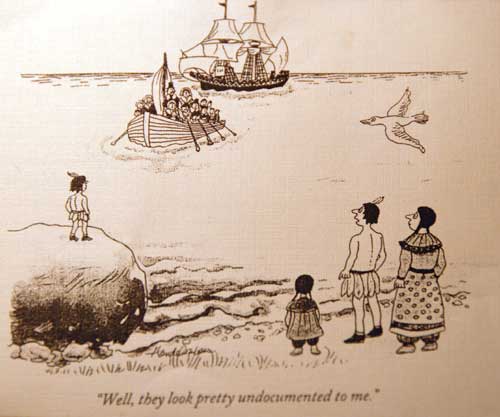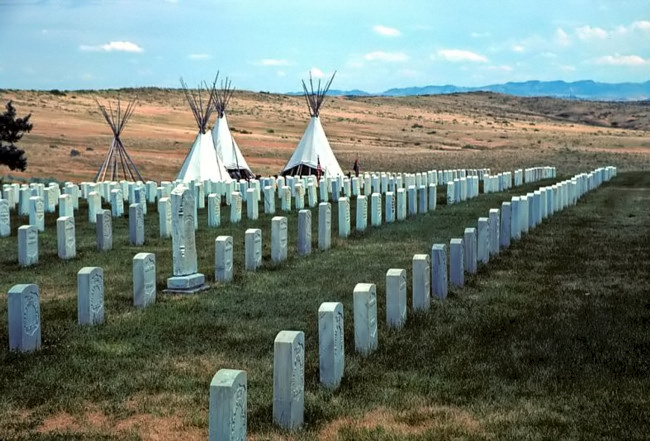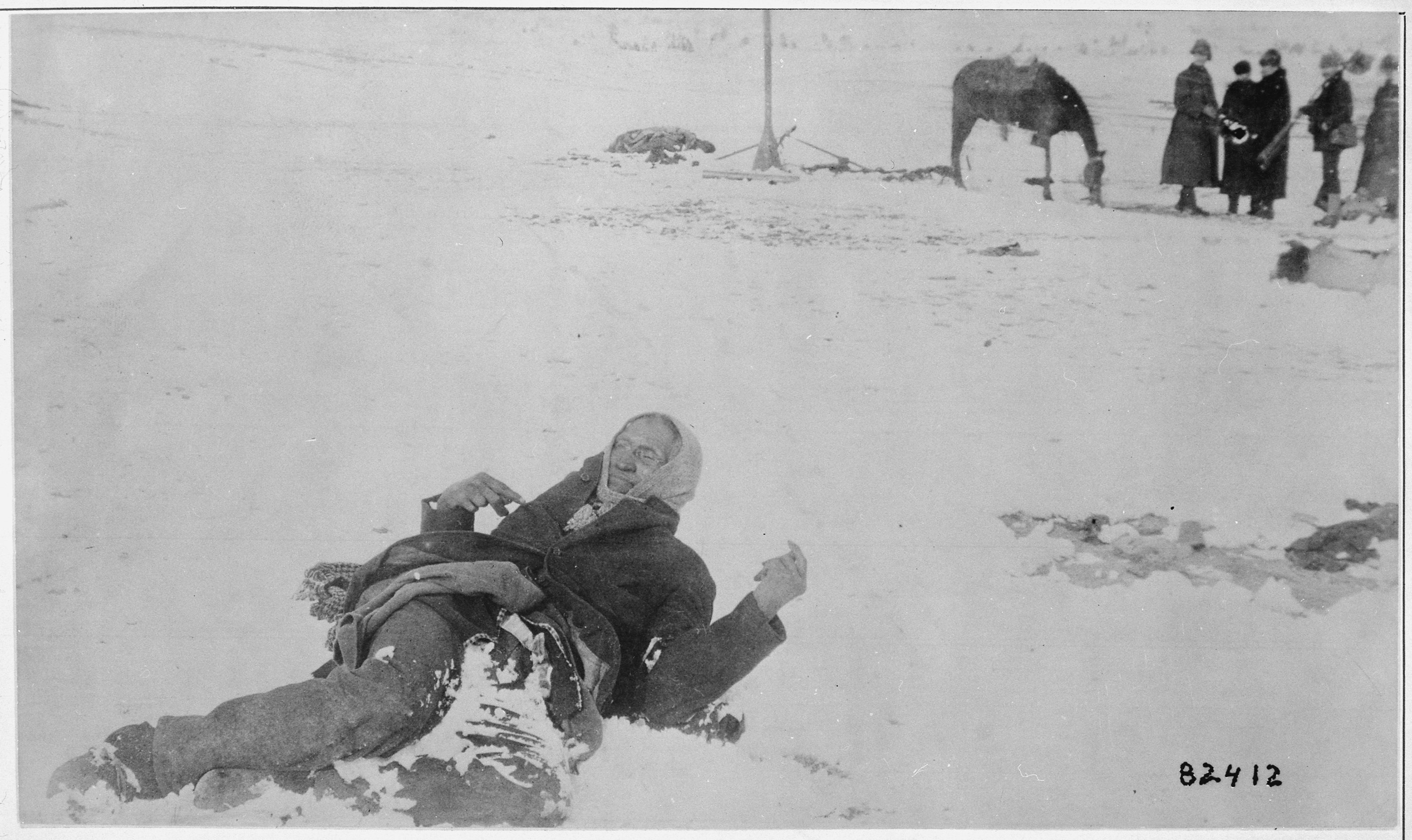
Indian Wars
For a Spanish translation

Obama: "Someplace else"
Indian Wars
is the name used in the United States to describe a series of conflicts between
White settlers or the federal government and the Indigenous population of North
America. The wars were the result of the arrival of European colonizers
who continuously expanded their territory pushing the Indigenous populations
westwards (See Emerging Values). The wars were spurred by ideologies such as the
"Discovery Doctrine" and "Manifest Destiny" that held that the United
States was destined to expand from coast to coast on the American continent, and
which resulted in the policy of Indian removal by which Indigenous peoples were
removed from the areas where Europeans were settling forcefully or by means of
voluntary exchange of territory through
treaties.
Often starting with the
Pequot War of 1637, Indian wars
raged throughout the 17th – 19th centuries, and tragically ending
with the Wounded Knee Massacre in 1890,
albeit also
with Battle of Bear Valley in 1918.


The last two "official" United States Indian Wars occurred in 19 January 1911, Washoe County, Nevada, considered The Last Massacre. Twelve Shoshones were killed by four ranchers and a posse. And then on 9 January 1918, at Bear Valley, in southern Arizona, The Battle of Bear Valley was fought. United States Army forces of the 10th Cavalry engaged and captured a band of Yaquis, after a brief firefight.
Example of the Sand Creek Massacre
29 November 1864
|
|
|
Looking southwest, Sand Creek or Chivington Massacre, 1864 |
The Sand Creek Massacre (also known as the Chivington Massacre, the Battle of Sand Creek or the Massacre of Cheyenne Indians) was an incident in the Indian Wars that occurred on November 29, 1864, when a 800-man force of Colorado Territory militia attacked and destroyed a village of friendly Cheyenne and Arapaho encamped in southeastern Colorado Territory, killing and mutilating an estimated 160 Indians, about two-thirds of whom were women and children. The location has been designated a National Historic Site and is administered by the National Park Service.
"Damn any man who sympathizes with Indians! . . . . I have come to kill Indians, and believe it is right and honorable to use any means under God's heaven to kill Indians." - Col. John Milton Chivington, U.S. Army
|
|
|
U.S. Army Colonel John Chivington's portrait. Chivington was a
Methodist preacher and an opponent to slavery |
1851 Treaty of Fort Laramie - seven nations, including Arapaho and Cheyenne, with their land between North Platte River and Arkansas River eastward to Rocky Mountains to western Kansas (present-day southeastern Wyoming, southwestern Nebraska, most of eastern Colorado and westernmost parts of Kansas.
1858 gold discovered in Rocky Mountains and Pikes Peak Gold Rush, flood of new immigrants,. and pressure to re-define Indian lands, resulting in 1861 Treaty of Fort Wise. Signed by only a few of the chiefs, including Black Kettle and White Antelope, who may have been bribed with gifts to sign, and without consulting or getting approval from the rest of the Cheyenne Council of 44 Chiefs and without consent of Dog Soldiers. Most Cheyenne disavowed the treaty agreement as it did not represent their wishes. (To be repeated with Nez Perce War of 1877 and Chief Joseph). Resulted in reservation 1/13 size of original lands, located in eastern Colorado between Arkansas River and Sand Creek. And Hostilities between Indians and settlers resulted.
A group of Black Kettle and White Antelope "friendlys," some making their way to Fort Lyon to establish their peaceful intentions, some 800 mostly Northern Cheyenne, camping near Sand Creek - on their reservation lands. Most men had gone to hunt, leaving camp with about 60 men and hundreds of elderly, women and children. Displayed American Flags and white flags.
Fresh off a victory defeated a Confederate force in New Mexico, Colonel Chivington and 800 troops marched on Black Kettle's camp. Night before, militia men drank heavily and anticipated victory. On morning of November 29, 1864, Chivington orders attach. Interestingly, two of officers and their companies refused his orders and stay out of the fight. But the unsought started.
An estimated 160 Indians were killed and mutilated, about two-thirds of whom were women and children. There were 24 soldiers killed, primarily due to "friendly fire," as a large number of the militia was drunk at the time of the attack.
I witness accounts:
I saw the bodies of those lying there cut all to pieces, worse mutilated than any I ever saw before; the women cut all to pieces ... With knives; scalped; their brains knocked out; children two or three months old; all ages lying there, from sucking infants up to warriors ... By whom were they mutilated? By the United States troops ... - John S. Smith, interpreter and trader in the camp at the time of the attack. Congressional Testimony of Mr. John S. Smith, 1865.
Fingers and ears were cut off the bodies for the jewelry they carried. The body of White Antelope, lying solitarily in the creek bed, was a prime target. Besides scalping him the soldiers cut off his nose, ears, and testicles-the last for a tobacco pouch ... - Stan Hoig, noted historian.
Jis to think of that dog Chivington and his dirty hounds, up thar at Sand Creek. His men shot down squaws, and blew the brains out of little innocent children. You call sich soldiers Christians, do ye? And Indians savages? What der yer 'spose our Heavenly Father, who made both them and us, thinks of these things? I tell you what, I don't like a hostile red skin any more than you do. And when they are hostile, I've fought 'em, hard as any man. But I never yet drew a bead on a squaw or papoose, and I despise the man who would. - Kit Carson, American frontiersmen (1809 - 1868).
Before Chivington and his men left the area, they plundered the tipis and took the horses. After the smoke cleared, Chivington's men came back and killed many of the wounded. They also scalped many of the dead, regardless of whether they were women, children or infants. Chivington and his men dressed their weapons, hats and gear with scalps and other body parts, including human fetuses and male and female genitalia. They also publicly displayed these battle trophies in Denver's Apollo Theater and area saloons.
Update: Cheyenne Spiritual Healing Run
1863 Bear River Massacre
Nez Perce Conflict of 1877 (Otis interviews 13)
Idaho's Forgotten War of 1975 - Kootenai of Bonner's Ferry (YouTube 10) Idaho’s Forgotten War profiles the courage and faith of 67 Idaho Kootenai people and the extraordinary woman, Amy Trice, who declared war on the United States government in 1974 to save her people. Robbed of their lands, culture, and hunting rights, the Kootenai people, move from place to place within a small isolated town called Bonners Ferry in Idaho. Far away from a way of life that no longer existed, the Kootenai people faced complete annihilation. By 1974, the Kootenai people had experienced extreme poverty. Homes given to the Kootenai’s by the Federal Government were decaying with broken windows and holes in the roof, providing minimal shelter to their owners. When a Tribal Elder freezes to death on a cold winter’s day inside his unheated home, the Elders fear it is only a matter of time before their entire Tribe disappears. This film documents the stories of the courageous young Idaho Kootenai woman and the people who experienced the war. Idaho’s Forgotten War will raise awareness about the last American Indian war declared against the U. S. Government on Sept 20, 1974. It will inspire viewers, and smaller Tribes to remain resilient in seeking Federal recognition for their people. What was once Idaho’s forgotten history, comes the true story about the Kootenai people and the woman, whose commitment would not waiver, and her courageous spirit that lead a bloodless war, and helped the Kootenai people rise out of the ashes to become a prosperous Indian Nation (from publicity).
For more information in the Indian Wars and the Sand Creek Massacre, and sources: http://en.wikipedia.org/wiki/American_Indian_Wars and http://en.wikipedia.org/wiki/Sand_Creek_massacre
return to Contact Schedule